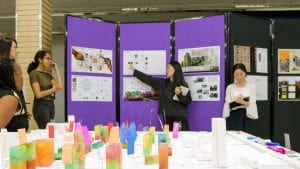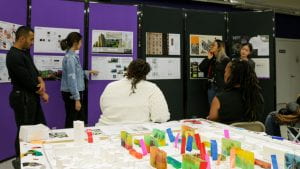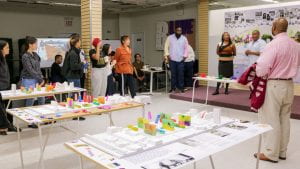
Its finally time for the long-awaited Community Engagement Day at Brownsville, Brooklyn. The Community Engagement Day was part of our midterm review and was held at the Brownsville Community Justice Center. It was an exciting day as the film, model and drawing teams got to share their work with the community and participate in the process of co-creation. The goal was to create conversations the neighborhoods and the stories of those that live there.
Inculcating community engagement as part of our design process has been groundbreaking in that the intersection of design and community engagement has provided us with new opportunities to interact with people who will be the users of the designs. We began to realize that our ability to empathize with the users of our design is an essential skill to have. By seeing our physical environment through the lens of others we can create innovative designs that can meet users’ needs. The key word today was transformation and not demolition – how can we give the community what they need without destroying what is present?
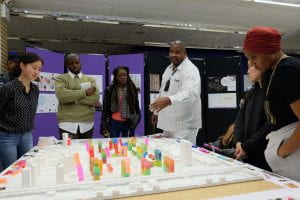
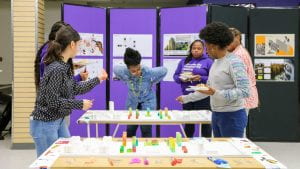
As we enter the space at the Community Justice Center, we first see the large drawing made by the drawing team. The drawing really stood out and helped to define the space at the review. The drawing seeks to draw out four different narratives and/or timelines of the neighborhood. The drawing begins by chronicling the history of the neighborhood over a period of 60 years from 1940 till today. The drawing then engages the community to chart their aspirations of the neighborhood – what they wish to have and what they like about it at the present. The drawing then wishes to draw out the stories of the residents going deeper into understanding who they are. The last part of the drawing gives the residents an opportunity to map out their day. All these different narratives intersect to create a collective reading of the neighborhood.
The model team followed a similar strategy in which they created a space for the residents to share their stories, memories and more. We wanted to know what Brownsville was to them, what makes it theirs, and what do they see as the future of Brownsville. Some of the key questions that emerged were “What were the spaces that amplified black joy?,” “What spaces made you feel most connected to the community?”, “What spaces made you feel safe or unsafe?” and “What were the spaces that promoted a sustainable future of drawing?” The model acted as a tabula rasa for people to engage and connect with as well as share their thoughts and ideas.
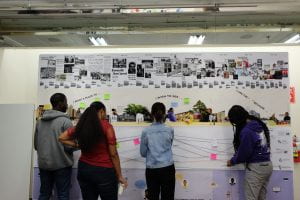
As we engaged with the community in the drawing and model we realized that we did not know more than the people who lived in the community and that it was important for us to make the residents feel comfortable and safe as they expressed and shared their thoughts and feelings. As the residents played with the model and drawing the conversations increasingly became about integration, breaking labels to create unified spaces for all, creating tactical interventions that can proliferate as well as dealing with ageing development. The three key words during the whole process was; redefine, reoccupy and reuse.
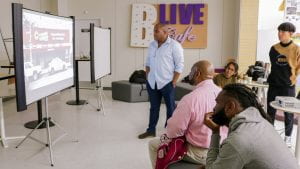
The film team showcased the voices of those in the community. It featured interviews of four different residents juxtaposed with the jarring images of the reality of the situation in Brownsville. Some of the conversations that emerged from the discussion about the film related to the power of journalism and how it shapes the perceptions of people. It made us question, “how can we create newsworthy experiences to transform the experience of space?” As consumers of mass media, we must be aware and critical of the reality that is presented to us. And as producers of a film, we must be aware of the lens that we are putting out there. The film overall brought together the good, the bad and the ugly to create something beautiful.
One key take-away from the whole session was that an important part of the process is to constantly check in with the community on whether what we presented is correct and accurate and what needs to be changed and revised. “Did we present and represent the voices well?”, “Is what we choose to represent what is?” and “What sort of impact does what we present have?” We ended the day by each one of us presenting our own ideas and proposals for the community. The ideas ranged from creating improved public space, rehabilitation of existing buildings as well as adding to the existing façade amongst others.
As we move forward during the semester, we hope to synthesize all the information gleaned from community input to create new opportunities and interventions for community to happen within Brownsville. We hope to be able to create designs that meet the vision of the community leaders, balance the wishes of the diverse voices and user groups and honor the history and heritage of the neighborhood. We left with the feeling that we were doing important work for the community by building consensus, understanding others’ needs and respecting the ideas of others. Our relationship with the community will continue as we create a sense of civic responsibility, engage stakeholders and create a sense of place for people.
